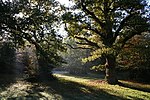Stoke Park, Buckinghamshire

Stoke Park is a private sporting and leisure estate in Stoke Poges, Buckinghamshire. The mansion building (designed by James Wyatt in 1788) is located in the middle of 300 acres (1.2 km2) of parkland, lakes, gardens and monuments. In 1908, it became the first country club in the UK. In 2013, it was awarded five red AA stars, the highest accolade for service and facilities for hotels, by The Automobile Association.Stoke Park has served as the filming location for several major films, including James Bond's Goldfinger and Tomorrow Never Dies, Bridget Jones's Diary and Layer Cake. It also hosts the annual Boodles Tennis Championships as a warm-up to Wimbledon, a week prior to the Championships. In June 2014, Stoke Park hosted an outdoor charity concert for SportsAid (patron: the Princess of Wales). Sir Elton John sang to 5,000 people and raised £825,000. On August 2, 2021, the venue closed for refurbishment followed by the golf course on October 18, 2021. It is expected to reopen in summer 2023.
Excerpt from the Wikipedia article Stoke Park, Buckinghamshire (License: CC BY-SA 3.0, Authors, Images).Stoke Park, Buckinghamshire
Park Road,
Geographical coordinates (GPS) Address Phone number Website External links Nearby Places Show on map
Geographical coordinates (GPS)
| Latitude | Longitude |
|---|---|
| N 51.5353 ° | E -0.60504 ° |
Address
Stoke Park Golf Course
Park Road
SL2 4PG , Stoke Poges (Beeches Community Board)
England, United Kingdom
Open on Google Maps







